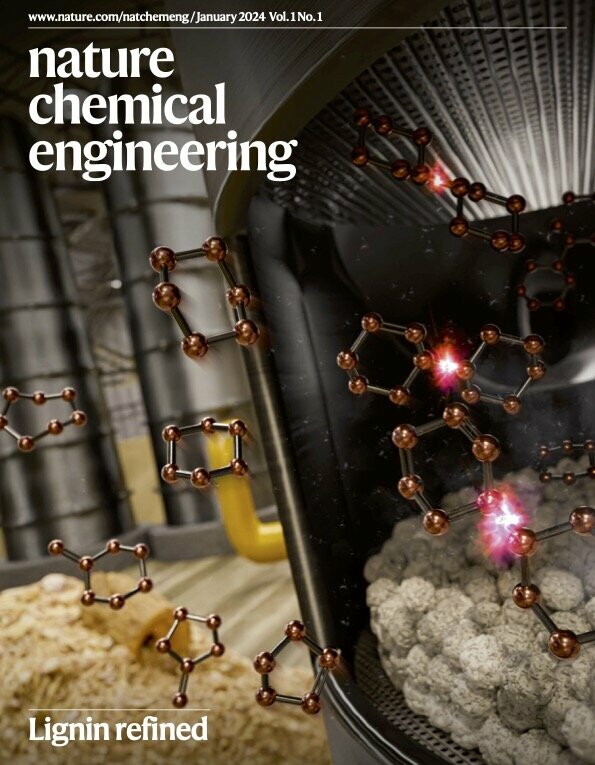There is a global consensus that humankind needs to move away from fuels produced from fossil feedstocks to curb the effects of climate change. While smaller vehicles turn to e-mobility, unfortunately, heavy-duty transport systems such as trucks, ships, and airplanes will rely on traditional liquid hydrocarbon fuels for the foreseeable future. As an alternative to fossil oils, these renewable fuels can be produced from plant-based lignin, but yields are limited by the current processing approaches, hampering the adoption of these alternative plant-based fuels. In a new study led by Emiel Hensen's research group at TU/e, a novel catalytic approach has been developed that can significantly improve yields from lignin by cracking hard-to-break carbon-carbon bonds.
At COP28 - the 2023 United Nations Climate Change Conference held in Dubai in December 2023 - an agreement was reached calling on all countries to help "transition away from fossil fuels in energy systems in a just, orderly and equitable manner".
This statement could be revised slightly to account for the technologies that we need in the future, according to Emiel Hensen, professor in the Department of Chemical Engineering and Chemistry.

Heavy-duty transportation
We need to move away from fossil feedstocks such as oil to produce hydrocarbon fuels.
"To be precise, we need to move away from fossil feedstocks such as oil to produce hydrocarbon fuels," says Hensen. "And that's because we are going to need hydrocarbon fuels for decades to come, whether we like it or not."
E-mobility technologies may be revolutionizing the family car, but largescale heavy-duty transportation such as ships and airplanes will continue to rely on hydrocarbon fuels for some time. "It's an inescapable fact: we are going to need hydrocarbon fuels to enable the energy transition for some time to come. But we don't need to make them from traditional crude oil. Instead, we can make them from renewable sources, such as lignin from plant biomass."
Does lignin pose problems?
Lignin is one of the major components in plant biomass, and it's this component that Hensen and others want to use to produce valuable fuels and chemicals. Currently, though there's a catch.
"In biomass, you'll find sugars and lignin. Sugars can be converted into ethanol, while chemicals and fuels can in principle be made from lignin. The catch is having an effective process that can do the latter," says Hensen.
Lignin is a polymer of so-called aromatic compounds (a planar ring of atoms stabilized by the interaction of bonds in the ring) that is difficult to disentangle. In terms of bonds, lignin is made up of easy-to-break and weak carbon-oxygen bonds and much stronger carbon-carbon bonds.
"Catalytic methods break the weak carbon-oxygen bonds with ease, but leave the carbon-carbon bonds untouched, thus limiting the yield of useful products from lignin," says Hensen.
So, in a study just published in the new journal Nature Chemical Engineering, which is featured on the inaugural cover, Hensen along with several TU/e colleagues working in collaboration with partners in the Netherlands, China, and Switzerland have cracked the carbon-carbon cleavage challenge using a new catalytic technology.
The road to cracking carbon-carbon bonds
So, how does the catalytic technology work? As Hensen explains, it requires a catalyst that can speed up two types of reactions at the same time.
"We found that a bifunctional catalyst that combines an activation step of the ring structures with a cracking step can selectively cleave carbon-carbon bonds," notes Hensen.
The strong carbon-carbon bonds in the lignin are pre-activated on metal nanoparticles. This pre-activation step weakens the carbon-carbon bonds, which can then be cracked on acid sites in microporous zeolites. The researchers found that bringing the metal and acid sites close together resulted in the highest yield of monomer products that can be used as multifunctional building blocks. These are required to make (synthesize) different types of fuels or chemicals.

"Thanks to our innovation, we have moved from carbon-oxygen bond cleaving to a technology where carbon-carbon bond cleaving can become the norm," says Hensen.
While this work is hardcore fundamental science and was predominantly completed in Hensen's group at TU/e, there was key input from around the world.
"From the TU/e side, Zhicheng Luo and Alexandra Radu carried out most of the work, with the idea coming from Luo who found the benefit of bifunctional metal nanoparticle/zeolite crystals for breaking carbon-carbon bonds," notes Hensen.
Luo's observation was just one part of the puzzle. The quantum-chemical calculations by Chong Liu, who is a former PhD researcher in Hensen's group and is now based at the Fujian Institute of Research on the Structure of Matter in Fuzhou in China, were crucial in terms of guiding the science. Added to that, the spinoff companies Vertoro from the Netherlands and Bloom from Switzerland helped in evaluating the approach by applying it to real lignin feedstocks.
Thanks to our innovation, we have moved from carbon-oxygen bond cleaving to a technology where carbon-carbon bond cleaving can become the norm.
Finally, an additional collaboration with Southeast University in Nanjing, China - the current host university of Zhicheng Luo - helped with the techno-economic analysis, showcasing the impact of the carbon-carbon bond cleaving.
"The solution we have devised enables the production of biofuels from lignin in substantially higher yields than realized so far. This can help makes lignin-based renewable fuel commercially viable," says Hensen.

The sky's the limit!
To test the effectiveness of the approach further, the new catalytic technology developed has not only been demonstrated with model components present in lignin but also with real lignin feedstock obtained from leading technology developers such as Bloom and Vertoro. "This means that the technology can be integrated into the industrial processes being realized at these spinoffs," says Hensen.
Thus far, Hensen and his collaborators have conducted experiments in batch reactors. "The next natural step is to evaluate the stability of the catalysts in continuous processes that are the norm in the chemical industry."
An additional complication for the researchers is the wide variability in terms of the chemical composition of lignin. "Such variability means that it is imperative to evaluate how impurities in regular biomass lignin samples affect yield," notes Hensen.
To use the lignin-derived parts to make sustainable aviation fuels for the aviation industry - which is one industry that needs to change how it accesses hydrocarbon fuels, the researchers will need to make the process 'milder' so that slightly heavier compounds could be obtained. "A milder process needs a lower reaction temperature and pressure. So, we are tailoring the catalyst to obtain molecules with two ring structures with high selectivity, which could immediately be blended with aviation fuels," says Hensen.
Blending would allow the fuels to be used in the current generation of airplanes engines too. In addition, these engines can be tailored to operate on lignin-only fuels, which could help transition entire transportation sectors to use sustainable fuel options only.






